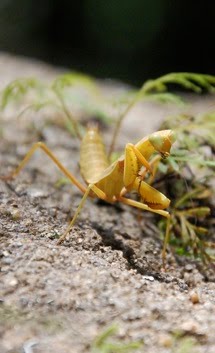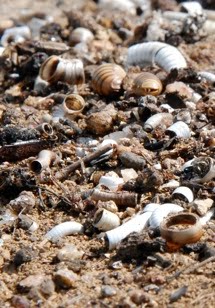Deforestation...Reforestation
A few weeks ago, I was lucky enough to be able to help replant some trees in Madagascar. I was volunteering for a day with Missouri Botanical Garden's Conservation Department. We drove a few hours northwest of our city, Antananarivo. The area is beautiful open country like eastern Montana, but it is not supposed to be so open. There should be a lot more trees and much larger forests. Trees are a very important part of this habitat. Insects, birds, mammals, reptiles and even other plants depend on them. But the trees are also very important to the people who live around here. Trees provide them with houses, charcoal for heat and cooking and materials for making products and crafts that may earn them some money. Most of the people in this part of the country are quite poor. Over half of them live on less than $1 a day. When everyone needs the trees, they cut them down and use them faster than new ones can grow, so the forests get smaller and smaller and smaller.
Many scientists from the island and all over the world are trying to make the forests grow again. It is not as simple as just saying, "You can't cut down trees anymore." Why not? [You may now pause to actually try and answer that with your class.]
Replanting trees in and around the small forests that are left is just one important step. That is what we are doing in the photos below. Can you think of some more steps that could be taken to protect the forests and the people at the same time? [You may pause again to answer this one as well.]
 This is the small, very small, forest fragment we were trying to protect. The green is the forest, but most of the large trees have all been cut by a logging company who sold the trees. Unfortunately, that means the local people didn't even get to use the wood.
This is the small, very small, forest fragment we were trying to protect. The green is the forest, but most of the large trees have all been cut by a logging company who sold the trees. Unfortunately, that means the local people didn't even get to use the wood. Here we are planting small trees. There about 20 of us and we each planted about 15 trees, so about how many trees did we plant?
Here we are planting small trees. There about 20 of us and we each planted about 15 trees, so about how many trees did we plant? This is a dangerous place for a little tree. For six months of the year it is very hot and wet and then the next six months are cold and dry. We used bamboo slivers to build teepees around each tree and then stuck fern fronds on the outside of the teepees to protect them from the drying sun and winds.
This is a dangerous place for a little tree. For six months of the year it is very hot and wet and then the next six months are cold and dry. We used bamboo slivers to build teepees around each tree and then stuck fern fronds on the outside of the teepees to protect them from the drying sun and winds. It was no accident that we used bamboo and fern fronds. They are both natural, and won't become trash when this is all over. They both grow very fast, so it is quite easy to grow and use more. Products like this are called sustainable, because they can be used by people without hurting the environment. Are the styrofoam plates and plastic forks and spoons in the cafeteria sustainable? Is there a solution to that problem? [The second to last pause to answer questions, I promise.] In the photo, some men are making bamboo slivers by simply hitting the dry bamboo stalks with hammers. It splits very nicely into long skinny pieces.
It was no accident that we used bamboo and fern fronds. They are both natural, and won't become trash when this is all over. They both grow very fast, so it is quite easy to grow and use more. Products like this are called sustainable, because they can be used by people without hurting the environment. Are the styrofoam plates and plastic forks and spoons in the cafeteria sustainable? Is there a solution to that problem? [The second to last pause to answer questions, I promise.] In the photo, some men are making bamboo slivers by simply hitting the dry bamboo stalks with hammers. It splits very nicely into long skinny pieces. Bonus Question:
This area of Madagascar was never just one big forest. It always had some grassland. And on that grassland there were vast herds of large grass-eating animals. So what big grazing animal do you think it was?
[Click on the movie the find out the answer.]






5 comments:
Good work, Mr. Lebo! It looks like efforts like this to plant trees are helping: Madagascar slows destruction of forests
Here's an aerial photo from northeast Madagascar that shows what deforestation looks like: National Geographic
Mr. Holsten
Excellent initiative but as you yourself said "the people in the area are very poor"
Attention should also be paid to addressing that need in reforestation projects.
Careful selection of tree species can both restore the environment and provide new income sources for peoples of extreme poverty.
One such species is paulownia. It has excellent regenerative powers for the environment and as the fast growing hardwood tree in the world rapidly provides new income sources for the extremely poor.
For more information on paulownia you may read www.paulownianow.org
The Conservation team in Madagascar for Missouri Botanical Garden is most certainly working on a systemic reforestation solution. They dedicated staff work with a very honest understanding of the people and their needs. I was simply just lucky enough to volunteer for a day.
The simplicity of the post was intentional. This is also a blog intended for elementary age students, so it was not possible or reasonable to try and address all aspects of this issue in a single post. The goal is for children to have an awareness of the delicate relationship that exists between humans and the environment.
Saving the planet is wonderful, but people are part of the planet too.
You Can Meet "Ozo," Philadelphia Zoo's New Sifaka Lemur Baby
Hey Mr.Lebo it's Jeremy, and Avery Peterson. Your website is very cool, and I have learned a lot from it. Thanks for making the blog!
Post a Comment